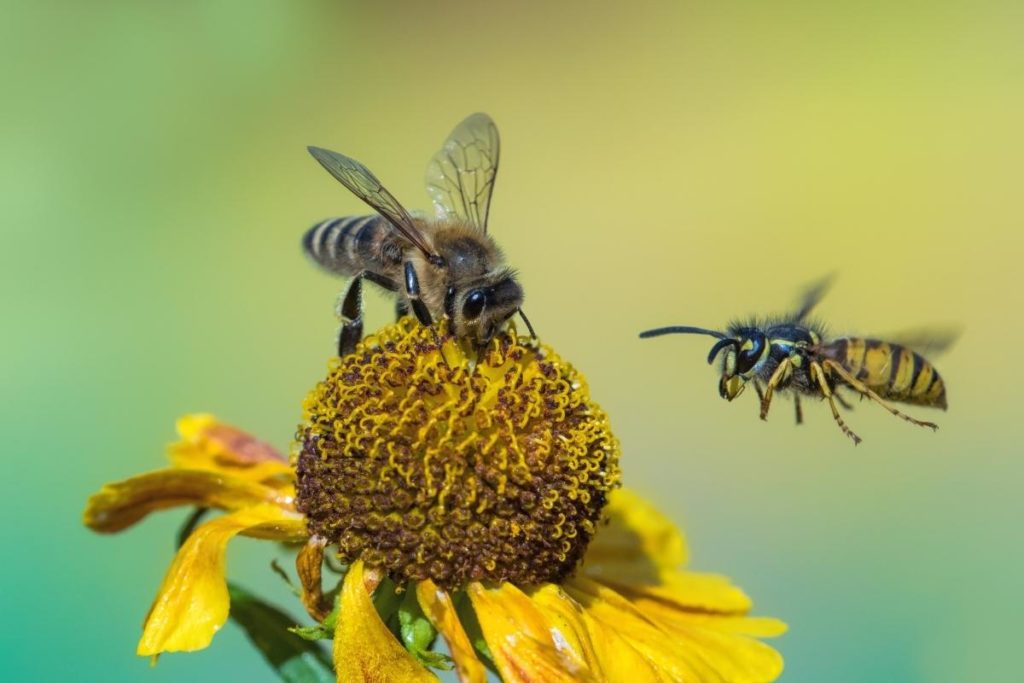How to Tell The Difference Between Wasps and Bees
Wildlife’s grace and natural beauty inspires awe and reverence, until it’s buzzing past your ear, swarming your picnic, and hassling your family. Learning more about the insects around you, including important distinctions like the difference between bees and wasps, helps you pre-empt hazards and keep yourself safe. Understanding the hazards and how to solve them helps your nearest and dearest enjoy their summers to the fullest.

Different Types of Stinging Insects in The UK
Britain hosts over 20,000 different insect species, but the stings, mobility, and proximity of wasps and bees often mean they’re more relevant to our day-to-day lives. Here are a few of the most common types found in the UK.
Solitary Bees
While honey bees are the most famous species of flying insect, there’s just one species of honey bee in Britain, and 250 species of solitary bees. Solitary bees live alone, as their name suggests, unlike honey bees and wasps who live in colonies often thousands strong. As their many species, including tawny bees, leafcutter bees, and masonry bees, operate outside of colonies, they don’t swarm, and you don’t need to worry about them.
Honey Bees
Great pollinators, food producers, and even movie stars, what’s not to love about honey bees? They’re non-aggressive and only swarm during late summer if they feel their hive is under threat. A fully-grown hive contains around 50,000 bees, leaving to find pollen exclusively on sunny days.
Wasps
Some experts put UK wasp numbers above the total British population, well over the 60 million mark, so you’re bound to bump into one or two over the summer. Britain’s two most common wasps, the Common wasp and the German wasp, both look and behave very similarly. The easiest way to tell them apart is by the three black dots at the top of the German wasp’s head, compared with the black anchor-shaped pattern on the Common wasp’s nose.
Hornets
Hornets stem from the same family as wasps, except they’re twice as big and prefer a diet of insects rather than sugary foods. As well as their distinctive size, hornets are golden brown and yellow rather than yellow and black. Their sting hurts more, and can even be deadly to humans.
The Difference Between Wasps and Bees Behaviour
Wasps tend to hover around humans and our food, while bees prefer flowers and plants. Honey bees can also use the same hive for several years, while wasps abandon their nest and build a new one every summer.
The Difference Between Wasps and Bees Appearance
Wasp bodies appear brighter yellow and darker black than bees. They also have fewer hairs on their bodies, and distinctively thin wasp waists, while bees are fluffier and rounder.
The Difference Between Wasps and Bees Nests
Bees and wasps nest in similar places, like holes in the ground, nooks in trees, and cavities in sheds and houses. However, when you get a closer look, the difference between wasps and bees nests becomes clear. Wasps use wood pulp to build nests, creating ridged, papery structures the rough size and shape of a football or rugby ball. By contrast, honeybees create sheets of beeswax with hexagonal pods for incubation and honey storage.
When to Intervene in Bee and Wasp Issues
If you can’t identify flying, stinging insects in your way, and they’re causing disturbances and hazards, it’s time to seek professional support. Bees and wasps are far more likely to sting when they feel threatened, and DIY treatment can cause wasps to release attack pheromones. Bee removal and wasp nest removal experts solve these issues quickly, safely, and humanely, so you don’t have to.
